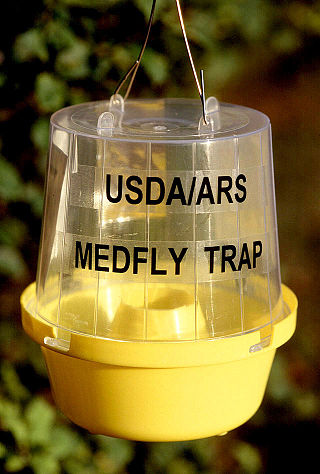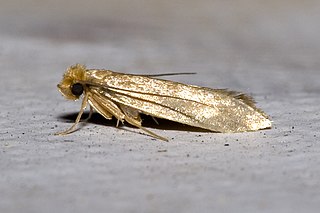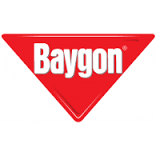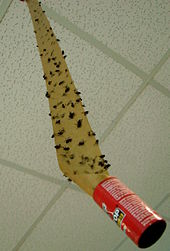
The bay leaf is an aromatic leaf commonly used as a herb in cooking. It can be used whole, either dried or fresh, in which case it is removed from the dish before consumption, or less commonly used in ground form. The flavor that a bay leaf imparts to a dish has not been universally agreed upon, but most agree it is a subtle addition.

Pesticides are substances that are used to control pests. They include herbicides, insecticides, nematicides, fungicides, and many others. The most common of these are herbicides, which account for approximately 50% of all pesticide use globally. Most pesticides are used as plant protection products, which in general protect plants from weeds, fungi, or insects. In general, a pesticide is a chemical or biological agent that deters, incapacitates, kills, or otherwise discourages pests. Target pests can include insects, plant pathogens, weeds, molluscs, birds, mammals, fish, nematodes (roundworms), and microbes that destroy property, cause nuisance, or spread disease, or are disease vectors. Along with these benefits, pesticides also have drawbacks, such as potential toxicity to humans and other species.

A poison is any chemical substance that is harmful or lethal to living organisms. The term is used in a wide range of scientific fields and industries, where it is often specifically defined. It may also be applied colloquially or figuratively, with a broad sense.

Insecticides are pesticides used to kill insects. They include ovicides and larvicides used against insect eggs and larvae, respectively. Acaricides, which kill mites and ticks, are not strictly insecticides, but are usually classified together with insecticides. The major use of Insecticides is agriculture, but they are also used in home and garden, industrial buildings, vector control and control of insect parasites of animals and humans. Insecticides are claimed to be a major factor behind the increase in the 20th-century's agricultural productivity. Nearly all insecticides have the potential to significantly alter ecosystems; many are toxic to humans and/or animals; some become concentrated as they spread along the food chain.
Roach bait is a modern pest control used for the extermination of cockroaches at indoor locations. The effectiveness of this method of pest control exploits the cannibalistic and coprophagic tendencies of cockroaches.

Carbofuran is a carbamate pesticide, widely used around the world to control insects on a wide variety of field crops, including potatoes, corn and soybeans. It is a systemic insecticide, which means that the plant absorbs it through the roots, and from there the plant distributes it throughout its organs where insecticidal concentrations are attained. Carbofuran also has contact activity against pests. It is one of the most toxic pesticides still in use.

Pest control is the regulation or management of a species defined as a pest; such as any animal, plant or fungus that impacts adversely on human activities or environment. The human response depends on the importance of the damage done and will range from tolerance, through deterrence and management, to attempts to completely eradicate the pest. Pest control measures may be performed as part of an integrated pest management strategy.

Fumigation is a method of pest control or the removal of harmful microorganisms by completely filling an area with gaseous pesticides, or fumigants, to suffocate or poison the pests within. It is used to control pests in buildings, soil, grain, and produce. Fumigation is also used during the processing of goods for import or export to prevent the transfer of exotic organisms.

Rodenticides are chemicals made and sold for the purpose of killing rodents. While commonly referred to as "rat poison", rodenticides are also used to kill mice, woodchucks, chipmunks, porcupines, nutria, beavers, and voles. Despite the crucial roles that rodents play in nature, there are times when they need to be controlled.

Diazinon, a colorless to dark brown liquid, is a thiophosphoric acid ester developed in 1952 by Ciba-Geigy, a Swiss chemical company. It is a nonsystemic organophosphate insecticide formerly used to control cockroaches, silverfish, ants, and fleas in residential, non-food buildings. Diazinon was heavily used during the 1970s and early 1980s for general-purpose gardening use and indoor pest control. A bait form was used to control scavenger wasps in the western U.S. Diazinon is used in flea collars for domestic pets in Australia and New Zealand. Diazinon is a major component in the "Golden Fleece" brand sheep dip. Residential uses of diazinon were outlawed in the U.S. in 2004 because of human health risks but it is still approved for agricultural uses. An emergency antidote is atropine.
A biopesticide is a biological substance or organism that damages, kills, or repels organisms seen as pests. Biological pest management intervention involves predatory, parasitic, or chemical relationships.
A fly-killing device is used for pest control of flying insects, such as houseflies, wasps, moths, gnats, and mosquitoes.

Insect traps are used to monitor or directly reduce populations of insects or other arthropods, by trapping individuals and killing them. They typically use food, visual lures, chemical attractants and pheromones as bait and are installed so that they do not injure other animals or humans or result in residues in foods or feeds. Visual lures use light, bright colors and shapes to attract pests. Chemical attractants or pheromones may attract only a specific sex. Insect traps are sometimes used in pest management programs instead of pesticides but are more often used to look at seasonal and distributional patterns of pest occurrence. This information may then be used in other pest management approaches.

Paris green is an arsenic-based organic pigment. As a green pigment it is also known as Mitis green, Schweinfurt green, Sattler green, emerald, or Vienna green, Emperor green or Mountain green. It is a highly toxic emerald-green crystalline powder that has been used as a rodenticide and insecticide, and also as a pigment. It was manufactured in 1814 to be a pigment to make a vibrant green paint, and was used by many notable painters in the 19th century. The color of Paris green is said to range from a pale blue green when very finely ground, to a deeper green when coarsely ground. Due to the presence of arsenic, the pigment is extremely toxic and in paintings, the color can degrade quickly.

Fungus gnats are small, dark, short-lived gnats, of the families Sciaridae, Diadocidiidae, Ditomyiidae, Keroplatidae, Bolitophilidae, and Mycetophilidae ; they comprise six of the seven families placed in the superfamily Sciaroidea.

Dichlorvos is an organophosphate widely used as an insecticide to control household pests, in public health, and protecting stored products from insects. The compound has been commercially available since 1961. It has become controversial because of its prevalence in urban waterways and the fact that its toxicity extends well beyond insects. Since 1988, dichlorvos cannot be used as a plant protection product in the EU.

Tineola bisselliella, known as the common clothes moth, webbing clothes moth, or simply clothing moth, is a species of fungus moth. It is the type species of its genus Tineola and was first described by the Swedish entomologist Arvid David Hummel in 1823. It and a number of closely-related species are together known as the clothes moths due to their function as pests in human households. The specific name is commonly misspelled biselliella – for example by G. A. W. Herrich-Schäffer, when he established Tineola in 1853.

Baygon is a pesticide brand produced by S. C. Johnson & Son. It is an insecticide used for extermination and control of household pests such as crickets, roaches, ants, carpenter ants, spiders, silverfish and mosquitoes. In 1975, Baygon introduced Australia’s first surface spray for killing cockroaches, ticks and other crawling insects.
Insecticidal soap is used to control many plant insect pests. Soap has been used for more than 200 years as an insect control. Because insecticidal soap works on direct contact with pests via the disruption of cell membranes when the insect is penetrated with fatty acids, the insect's cells leak their contents causing the insect to dehydrate and die. Insecticidal soap is sprayed on plants until the entire plant is saturated because the insecticidal properties of the soap occurs when the solution is wet. Soaps have a low mammalian toxicity and are therefore considered safe to be used around children and pets, and may be used in organic farming.
Physical pest control is a method of getting rid of insects and small rodents by killing, removing, or setting up barriers that will prevent further destruction of one's plants. These methods are used primarily for crop growing, but some methods can be applied to homes as well.















